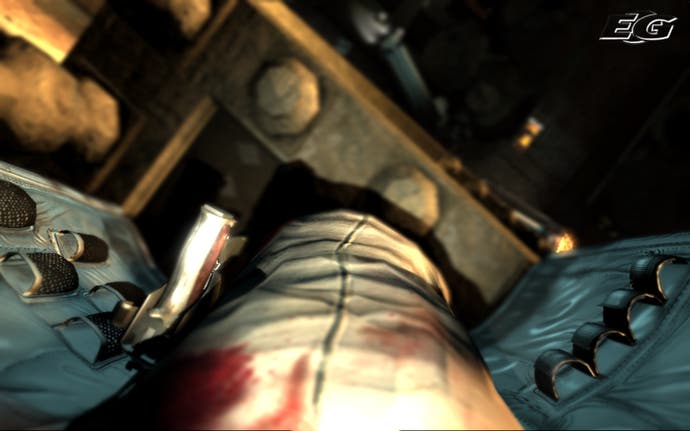Alone in the Dark
Arson about.
Here's a situation with which everyone who plays videogames will be familiar: you're playing as a heavily armed character, who has shot, punched, smashed and looted his way through wave after wave of monsters, zombies, henchmen or aliens - only to be foiled, despite your bulging muscles and impressive arsenal, by a plywood door. Kick it in? Shoot it? Blow it up? Nonsense - it's time to go and look for the four pieces of the sacred medallion that'll make it open!
The first defining moment of our early glimpse of Atari's upcoming resurrection of Alone In The Dark came when we ran into a dead-end and a locked wooden door. We waited patiently for the game's lovely next-gen graphics and great presentation to be let down by the inevitable locked-door puzzle.
Not this time. Edward Carnby, fresh from his unpleasant adventure in the original Alone In The Dark and mightily pissed off to be right back in the gory, supernatural fray, has no time for locked-door puzzles. Plywood door? Find something solid and beat the hell out of it until it smashes off its hinges. Set fire to it, then kick it through when it's smouldering. Smash the window next to it and climb through. Or, as a final resort, you could always find the key - but why make things hard for yourself?
I Think We're Alone Now

Based on Alone In The Dark's pedigree, we approached the early code we were shown fairly certain that it would be stylish, well-presented, but ultimately fairly typical of the survival-horror genre. It may have invented the genre before Resident Evil was even a twinkle in Shinji Mikami's eye (which, presumably, nobody could see because Mikami never takes off his sunglasses), but Alone In The Dark has done little to drive it forward with subsequent games.
That pre-conception didn't last ten minutes. Oh, it's stylish and well-presented, that's for sure - but Alone In The Dark is also one of the most ambitious games we've seen in ages, taking Half-Life 2-style physics and item-manipulation and bringing them to the next level entirely. The ability to break plywood doors isn't just a gimmick, it's a symptom of a consistent, flexible and believable physics system that creates a world with no locked doors, multiple solutions to every problem, and a singularly extraordinary combat system.
A minute later, we're standing outside a steel door. Ah, familiar territory - the plywood doors can be broken, but the steel doors are impregnable, right? Wrong. Go and find something nice and heavy to use as a ram (a fire extinguisher does nicely), and you'll be able to batter it out of shape until it smashes open. Run into a puzzle where an electric cable is dangling into some water, and you could of course go and find the fuse box to turn off the power - or alternatively, you could grab a stick, fish the cable out of the water, and proceed. If you're feeling especially nasty, you could even use the live cable to electrocute a nearby grille that some enemies are standing on. Mmm, crispy.
That touches on the second aspect of this lovely physics engine - combat. In this game, Carnby isn't Rambo - he's MacGyver. Your inventory, which in a nice touch uses an interface where Carnby simply opens his jacket and looks at all the various items he's picked up and stowed in there, is full of things like bottles of booze, sticky tape, healing sprays, Zippo lighters, blood packs from medical centres, tissues and fuel canisters. These, combined with the environment around you, are your weapons - the gun and knife Carnby can wield are useful, but the real fun lies in working out how to kill your foes more creatively.

An example: throw a fuel canister at an enemy with your gun pulled out; it'll fly out along an arc in gentle slow motion, allowing you to shoot it and make it explode in a fiery mess at any point on the way. Another example: stab a bottle of petrol with a knife, then apply sticky tape to it. Target an enemy and throw the bottle at him; it'll stick, and as he shambles off, he'll leave a trail of fuel behind him. Light the fuel trail from a safe distance and watch him go up in flames.
Things get more complex, and more entertaining. The game's central portion is a huge, free-roaming space - the entirety of New York's Central Park modelled, complete with sewers, underground tunnels and building interiors. There are vehicles littered everywhere, and Carnby can get into any of them and drive (either hunt for the keys inside the car or on nearby corpses, or just hotwire the car). He can also stab the fuel tank with a screwdriver and drive into the middle of a group of enemies, then run back, find the fuel trail on the ground, and light it. Kaboom.
A simple but terribly clever system makes all of these complex manipulations possible. You can pick up anything in the world, within reason, and then use the right analogue stick to move it around in front of you. Flick the stick rapidly left and right to swing the object like a weapon; flick it back and forward to bring it down over your head in a crushing blow. Hold it in front of you and stick it into a fire to set it on fire, the flames licking and spreading realistically over the object; hold it upright to keep the flames from spreading quickly to your hands and burning them.


.png?width=291&height=164&fit=crop&quality=80&format=jpg&auto=webp)




.jpg?width=291&height=164&fit=crop&quality=80&format=jpg&auto=webp)
